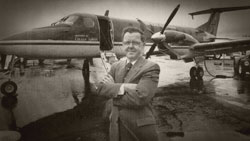
Charles Colgan founds Colgan Airways Corp. at Manassas Airport, Manassas, Va. At first Colgan does not fly its own planes; it serves as the fixed-base operator at Manassas Airport refueling and servicing other aircraft.
Under contract with IBM, Colgan begins scheduled flight service between Manassas, Washington's Dulles Airport and Poughkeepsie, N.Y.
Under deregulation in the late '70s, the federal government creates the Essential Air Service Program, which gives subsidies for regional airlines, including Colgan, to fly to rural communities.
By this time Colgan is flying nine aircraft and operating in 12 cities.
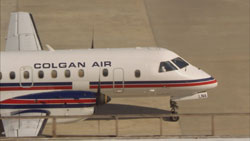
Charles Colgan and his son Michael Colgan start a new airline business under the name Colgan Air.
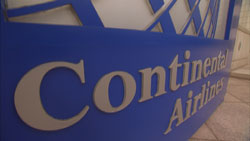
Colgan signs its first code-share contract with Continental Airlines, operating under the Continental Connection designation on flights to 10 cities in the Mid-Atlantic and northeastern regions. Under the code-share agreement, Colgan would operate the planes, but the planes and the crew would be branded to look like Continental, which would sell the tickets.
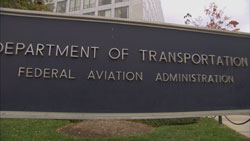
As Colgan grows as a regional airline, the company is supposed to upgrade its operations to meet the same level of safety as the major airlines. But in a letter to the FAA, it acknowledges that it would have to make significant improvements in order to meet those more stringent safety standards, known as Part 121 regulations. Colgan commits to making substantial changes in pilot training, record keeping, management, maintenance and safety audit systems. The letter is signed by company founder Chuck Colgan.
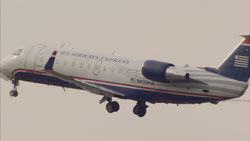
Colgan separates from Continental Airlines and becomes an exclusive US Airways code-share partner, operating under the US Airways Express designation.
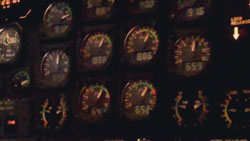
A US Airways Express flight operated by Colgan crashes near Cape Cod, killing the two pilots. No passengers are onboard. The National Transportation Safety Board (NTSB) cites improper plane maintenance as well as inadequate pilot inspection of the maintenance performed as the probable causes of the accident.
Chris Monteleon, the FAA's principal operations inspector of Colgan Air, raises several safety concerns about the carrier. Monteleon says that when he advocated for enforcement action within the FAA< his office manager would not approve them, allegedly saying, "Mike Colgan [company president] is a friend of this office." The FAA tells FRONTLINE that hte office manager does not recall making that statement, but if he did, it was not to suggest that the company would receive any preferential treatment.
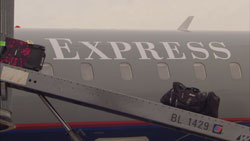
Colgan starts flights for United Express out of Washington, D.C.'s Dulles Airport. Today, Colgan still code-shares with United Express, flying to multiple destinations in New York, Pennsylvania, Virginia and West Virginia.
A safety audit of Colgan performed by the Department of Defense documents safety problems at the airline. The DoD performs safety audits of airlines with which it contracts for air carrier services. Its audits are closely studied in the industry; major airlines including Continental use them when assessing safety of their regional partners.
The DoD notes an inadequate internal quality audit program at Colgan. It states that the "Company has not adequately maintained a safety feedback structure that informs management of safety policy results, including possible safety problems," and issues a letter of concern to Colgan about its safety manuals, but allows the carrier to continue service.

Growing rapidly through a series of code shares with United Express, US Airways Express and Continental Connection, Colgan services 58 locations in the East, Northeast and Southwest U.S. Between 2001 and 2005, Colgan nearly triples the number of planes it operates, and annual revenues grow from $55 million to more than $136 million.
Shortly after this $20 million deal, Continental signs a contract with Colgan to operate 15 new 74-seat Bombardier Dash-8 Q400 turboprop planes out of Newark, N.J. The agreement stipulates that Colgan will start flying the planes for Continental beginning February 2008.
In another audit of Colgan, the Department of Defense cites similar problems as in its 2005 audit. DoD put Colgan on a "Closewatch" list due to "lack of management"; it requires corrective action but allows Colgan to continue service. Internal FAA reports obtained by FRONTLINE show the agency was aware of the DoD audit. However, according to the NTSB, the lead FAA inspector for Colgan did not ask for full copies of the audit. By June of 2008, the DoD notes the company had completed its corrective action.
As stipulated in its agreement with Continental, Colgan begins to fly the Bombardier Dash-8 Q400 out of Newark.
The FAA and Colgan note several problems with pilot operations' of the new Q400 fleet that would eventually crash in Buffalo. According to internal Colgan correspondence, FAA inspectors observe numerous problems in the cockpit, including airspeed limitation compliance, incorrect use of the automated control system, and incorrect cabin-to-cockpit communications procedures. The correspondence also shows Colgan was short on supervisory pilots for its new fleet.
Responding to FAA concerns, Colgan conducts a series of observation flights to monitor flight speed. According to NTSB testimony by Sheri Baxter, Colgan manager of flight standards, the observation runs are successful. But former Colgan pilot Corey Heiser tells FRONTLINE the company pulled him in to supervise the flights, though he had not yet been trained to fly in the new Q400 plane.
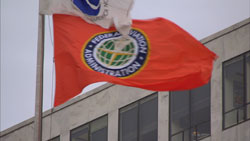
Christopher Monteleon, the inspector who raised concerns about Colgan inside the FAA in 2005, reports to the U.S. Office of Special Counsel that he had observed numerous and repeated safety infractions and violations at the airline between 2005 and 2007. Monteleon claims that he had been removed from his duties overseeing the carrier due to his enforcement efforts, and he files for federal whistleblower protection.
The Department of Transportation's Inspector General's Office reviews Monteleon's complaints and determines that he was not removed from his position overseeing Colgan because of his attempts to initiate enforcement actions against the company. The IG review substantiates two of Monteleon's complaints about safety violations, but does not find enough evidence to substantiate eight other complaints.
A routine calculation of the weight limit on a Colgan-operated flight out of New York City shows that the plane, carrying 35 adult passengers, is too heavy to fly. An FAA investigation finds that in order to make the flight legal, the captain alters the official records.
The investigation, initiated after a complaint filed by the first officer on the flight, results in the revoccation of the captain's license; however, at an appeal hearing, Colgan testifies on behalf of the captain. "I don't understand why they would come in and support him," Loretta Alkalay, the FAA's regional attorney in charge of the case, tells FRONTLINE. "It was breathtaking in its horror at the time. I mean, it was horrifying."

Ten months after introducing the Bombardier Dash-8 Q400 into its flight line, Colgan Air has still not finalized the airplane's operation manual -- a critical set of guidelines for pilots. Former Colgan pilot Corey Heiser tells FRONTLINE manuals are critically important for pilots. "They tell us how to operate it in varying conditions," he explains. "[The manual] tells us how to operate it when abnormalities and emergencies happen." Between December 2008 and March 2009, all work on the manual stops. Colgan Air cites company workload as the reason behind the gap.
Continental amends its contract to double the number of Q400 aircraft flown by Colgan beginning in the third quarter of 2010.
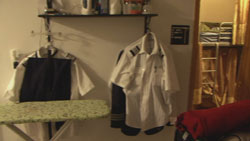
Capt. Marvin Renslow commutes from his home in Tampa, Fla., area to Newark to begin a three-day trip.
Renslow, 47, is a new Q400 pilot, having completed his training two months before the accident. According to a supervisor involved in his training, the captain is slow learning the plane in the beginning, but his abilities picked up toward the end.
Renslow had flown for Colgan for more than three years and had obtained his commercial certificate training at Gulfstream Academy. Before becoming a captain, Renslow held various jobs, including sales representative at Verizon, stock clerk at a grocery story, and Continental reservations agent. Renslow lived in the Tampa, Fla., area, was married for 24 years and had two children.
First Officer Rebecca Shaw wakes up at home outside of Seattle, Wash., between 9-10 a.m. PST. Shaw, 24, is also new to flying the Q400, having finished training for the plane a few months before Renslow.
Shaw previously had been based out of Norfolk, Va., where she worked at a coffee shop on her days off from flying. She moved to Seattle to be with her family. She was married and had no children.
The morning before Flight 3407, Shaw flies from Seattle to Memphis Tenn., in a jump seat on a FedEx airplane, which arrives about 2:30 a.m. EST on Feb 12. Around 4:20 a.m., Shaw takes another jump-seat flight from Memphis to Newark with an approximate arrival at 6:30 a.m.
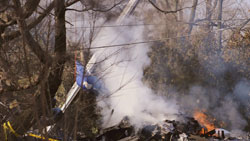
The Continental Connection Flight 3407 crew is scheduled to report for duty at 1:30 p.m. at Newark. After arriving, they wait around the airport because their first two flights for the day are canceled due to high winds.
Flight 3407 is scheduled to depart from Newark, N.J., at 7:45 p.m., but is delayed, and ultimately takes off at 9:18 p.m. At 10:16 p.m., the flight crashes in Clarence Center, N.Y., five miles away from the Buffalo Niagara Airport. Fifty people are killed (49 on board, one fatality on ground due to the crash). Conditions on the ground in Buffalo were variable, with mist and light snow, and visibility of less than three miles.
In the immediate wake of the crash, Colgan releases a statement [PDF]: "At this time, the full resources of Colgan Air's accident response team are being mobilized and will be devoted to cooperating with all authorities responding to the accident and to contacting family members and providing assistance to them."
The bulletin reiterates the company's fatigue policy and provides information on what causes fatigue, how to recognize signs of fatigue, how fatigue affects performance and how to combat fatigue.
The NTSB holds three days of public hearings on Continental Connection Flight 3407 in Washington, D.C. The hearings are also telecast in Buffalo, N.Y; New York City; and Newark, N.J.
The hearings concentrate on issues such as Capt. Renslow's lack of stall-recovery training, First Officer Shaw's commute and low pay, Colgan's pilot hiring and training practices, and pilot fatigue. A transcript of the cockpit voice record is released; it notes sounds similar to yawns from both pilots and frequent sniffles from First Officer Shaw. "If I call in sick now," she says, "I've got to put myself in a hotel until I feel better." She also talks about having made $15,800 in her first year at Colgan.
The NTSB finds that pilot errors and insufficient training were key factors contributing to the crash. Specifically, it faults the captain's inappropriate response to the activation of the stick shaker, which led to an aerodynamic stall from which the airplane did not recover.
Other contributing factors were the flight crew's failure to monitor airspeed, the flight crew's failure to adhere to sterile cockpit procedures, the captain's failure to effectively manage the flight, and Colgan Air's inadequate procedures for airspeed selection and management during approaches in icing conditions.